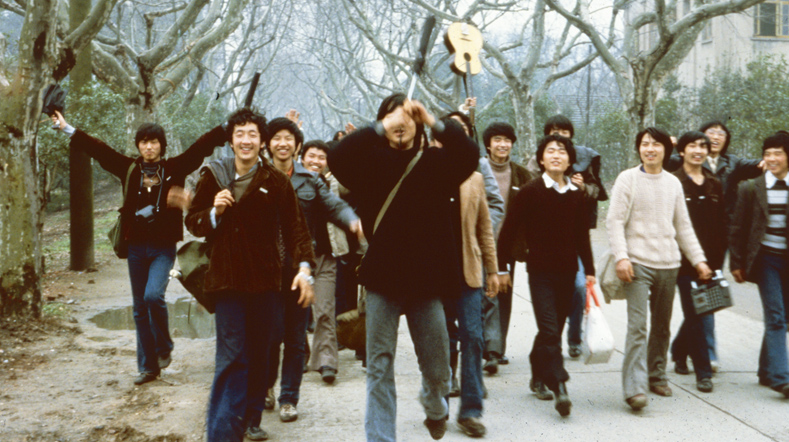
Above: Art Academy Students returning from a picnic.
Right: Roman and his wife Alice Wagstaff with Yan Bo (center).
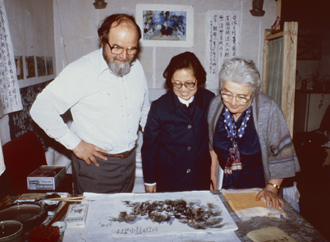
Main Menu | Site Map | Search | Contact | Archive | History | Statement | Copyright
CHINA NOTES: 1981, 1985, 1998
 |
|
| 1985 Spring Term Above: Art Academy Students returning from a picnic. Right: Roman and his wife Alice Wagstaff with Yan Bo (center). |
 |
My China Experience began with a study tour in 1981 guided by the Venerable Sister Baulu Kuan who had been born and raised in China. Sister Baulu Kuan, on the art faculty at the College of St. Benedict, St. Joseph, MN, provided a preliminary seminar on Chinese Art & Culture for participants. Beginning in Hong Kong and traveling by train and bus, Sister Balu's travel seminar included cities and archaeological sites in Eastern, Central and Northern China. Sites and cities included Xian, Guangzhou, Buddhist sites in Northern China, Beijing, the Ming Tombs, the Tianjin port, and the Bohai Sea coast where the Great Wall begins.
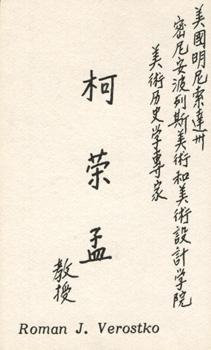 |
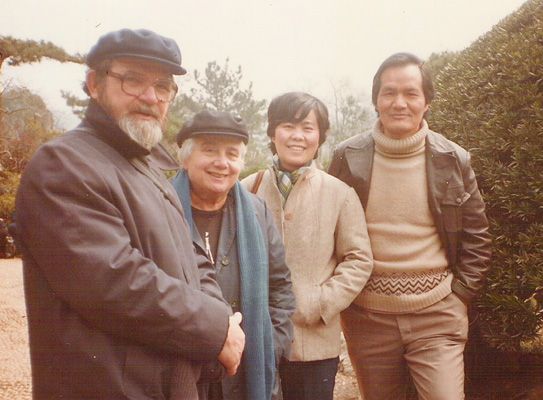
|
|
Left:
The name card I carried in China. .(see SEALS
for name translation). Right: Myself, Alice, Zheng's wife Aikong and Zheng Sheng Tian, Hangzhou, 1985. |
|
The following year I met Zheng Sheng Tian who was in residence at the University of Minnesota. That meeting turned into a friendship and an exchange that had a profound impact both on my life and his. His work and vision for China played a crucial role in the transformation of contemporary Chinese Art, a transformation that would become known internationally. See: Art and China's Revolution Edited by Melissa Chiu and Zheng Shengtian (November 2008)
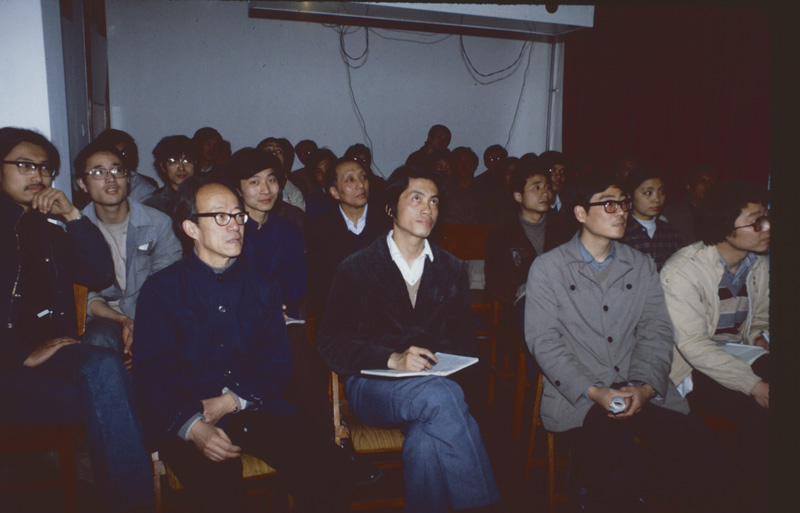 |
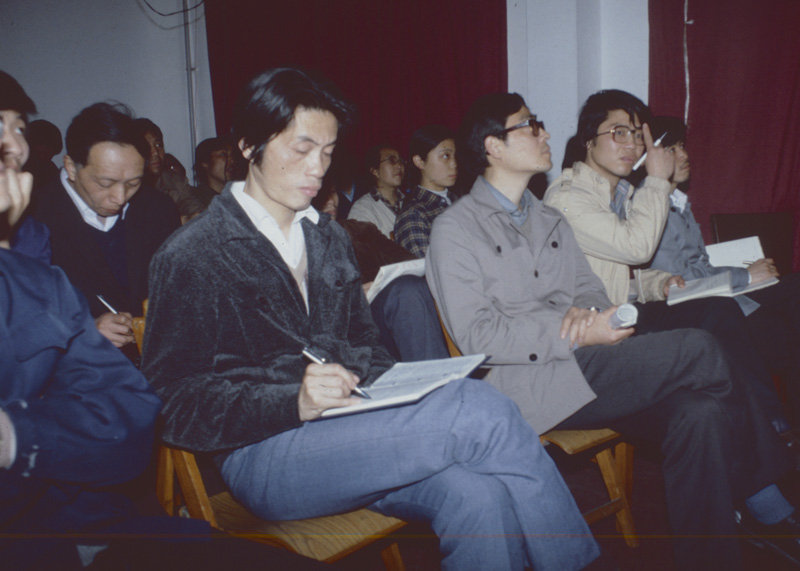 |
|
Above: My class at the art academy in Hangzhou, Spring Term, 1985. |
|
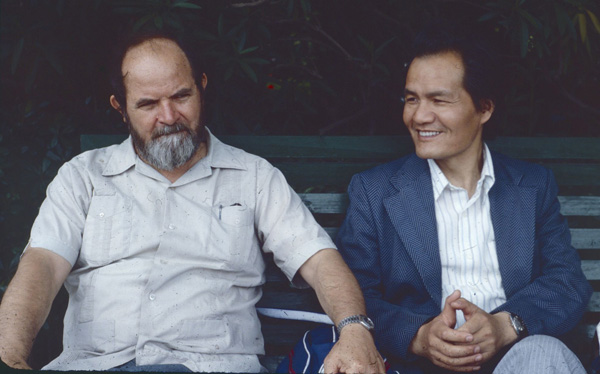 |
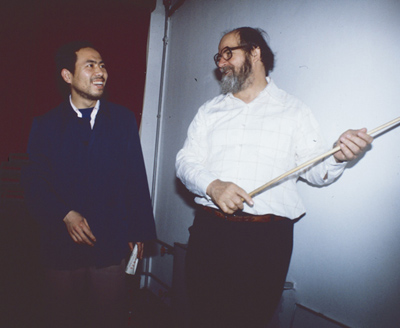 |
|
I meet with Zheng Sheng-tian,
Shanghai, 1985. I was on my way home after my lecture tour to 5 other art academies. |
Shen
Wei Hui (translator)
shares a |
1985 ZHEJIANG ACADEMY OF ART (浙江美術學院), SPRING TERM
( In 1993 the ZHEJIANG ACADEMY OF ART changed its name to the CHINA ACADEMY OF ART )
During the academic year of 1983-84 Zheng Shengtian attended some of my lectures in 20th Century Art at the Minneapolis College of Art & Design. Later, in 1984, he invited me to teach my course on Twentieth century Art History at the Zhejiang Academy of Art in Hangzhou for the Spring term in 1985.
The Academy in Hangzhou invited young teachers from other Chinese Art Academies to come to Hangzhou to follow my course. Following the course the teachers returned to their respective Academies to share their experience. Four of those teachers helped arranged for me to present a one week series of slide lectures at Nanjing, Tianjin, Chongqing and Wuhan. The Wuhan lecture was aborted due to travel exertion. However I was able to add one lecture session at the Academy in Beijing.
I prepared about 2,000 slides on 20th Century Art and I requested a teaching space with two slide projectors for parallel image projection. Zheng Sheng-tian arranged to have my syllabus translated into Chinese. I prepared slides and terminology notes each day in advance for my translator, Fan Xiao Ming, who was an immense help for me.
DOCUMENTATION OF MY 1985 COURSE:
THE HISTORY OF MODERN ART IN WESTERN SOCIETY
OUTLINE: Chinese Version / English Version
NOTE ON "THE FUTURE OF ART & THE ARTIST":
This final session, unlike the others, was opened to the entire student body. My experience as an active and contributing member of the World Future Society led me to introduce this unit in my courses at the Minneapolis College of Art & Design. I viewed it as crucial and especially appropriate for this time in China. It focused on social and ecological issues confronting the artist in our changing world. See the outline for my last lecture #15, "The Near Future", in my syllabus: English Version / Chinese Version /
As a bonus we were able to borrow two computers from the computer science department at the University. Following my presentation on the "future" we took a short break. Then with the help of my wife, we demonstrated some elementary computer graphics and word processing. For many students, at that time, it was their first experience of computer graphics. This may possibly have been the first time that computer graphics had ever been shown in an art school campus in China. I should note, of course, that the Zhejiang University ( 浙江大学 ) did have a department of computer science that included research on intelligent systems. The forthcoming change in China was be rapid and significant. When I returned 13 years later, in 1998, they had a fully equipped computer lab and department. The change was more than I ever imagined possible in 1985.
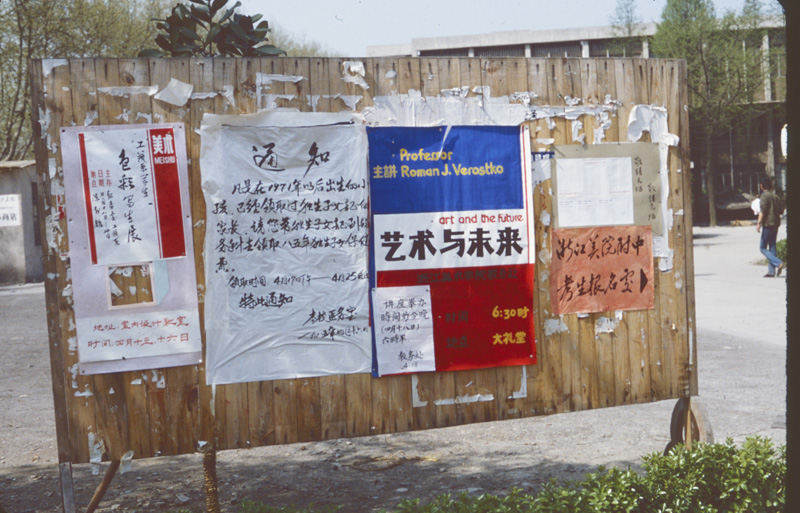
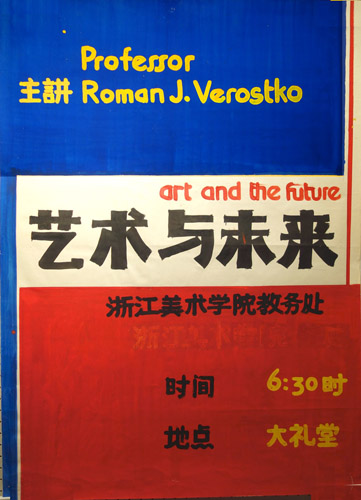
"Art &
the Future, 6:30 PM, April 18, 1985
Announcement board with the poster
for my final lecture.
_______________________________________________________________________________
1998 CHINA ACADEMY OF ART 中国美术学院 , Hangzhou, PRC
The CHINA ACADEMY OF ART was known as the ZHEJIANG ACADEMY OF ART from 1958 to 1993.
In 1998 I was invited back to the Academy to present a one week seminar on Algorithmic Art. The Academy was still located along West Lake but there were many changes along the lake and our accommodations were much better. Fan Xiao Ming who had translated for my course in 1985 was also my translator for the seminar.
SEMINAR OUTLINE FOR 1998:
SESSION I: HOW ONE ARTIST THROWS DICE: Form-Generation As Epigenesis
This presentation identifies features of automated procedures I have evolved over the past decade including their origins, their precedents in early modern art and selected phases in their evolution up to the present time. Works shown include folios from the Diamond Lake Apocalypse, which won the artist the Golden Plotter first prize in 1994 (Gladbeck, Germany).
Allow about 45 minutes for presentation and then time for discussion.. This session concentrates on my work and will allow the student to see how the use of a computer may be applied to a highly individual style.
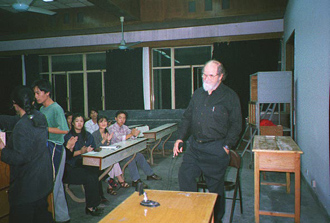
Photo of Roman and those who participated in this seminar (1998)
SESSION II: ART & ALGORITHM, Classical Traditions Revisited
This session identifies the nature of "form generating" algorithms and the unique power they provide when designed for and driven by computers. This session probes the relationship between art and the calculus of form by showing selected examples from prehistory to the present day. I will illustrate algorithmic art today with both my own work and that of my peers. This includes examples from the Ezekiel series for which I received a Prix Ars Electronica honorable mention in 1993.
For the Academy at Hangzhou we will include some example from Chinese tradition. For example the “Mustard Seed Manual…” may be viewed as a collection of algorithms. This session will help students see the relationship between computer programming and historical methods where procedure was “programmed”!
SESSION III: TOWARDS THE FUTURE (Discussion Forum)
Computing procedures in future art: opportunities and pitfalls.
Introductory remarks by Roman Verostko on issues related to the future of art and computing. This session will discuss subjects such as the relation of the art object to recursive computing functions and cyberspace. Items: (a) The impact of "software" on artistic style, (b) fine art in cyberspace (c) The role of the fine art object in a cyberspace culture.
Response and discussion with students and staff.
Presentation summary :
Chinese Arts (Shanghai: 1999, pages 14 & 15):
Page 14 (423 kb) > | Page 15 (484 kb) >>
Schedule:
Roman Verostko slide lectures at Hangzhou, 1998:
Oct. 13, 6:30-9:00 PM. Form Generation As Epigenesis.
Oct. 14, 6:30-9:00 PM. Art and Algorithm: Classical Traditions Revisited.
Oct. 15, 6:30-9:00 PM Computing procedures in future art: Opportunities and pitfalls (Open Forum)
Supplementary Documents
| Teaching in China by Roman Verostko, ARTS: A Culture in Transition, January 1986, Minneapolis Society of Fine Arts, pp. 16 ff. | |
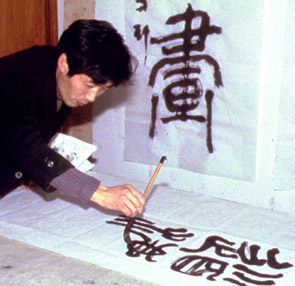 |
The China Factor: The influence of China on my work and the influence of my work in China is discussed by Shao-Lan Hertel in her essay, "Lines in Translation: Cross-Cultural Encounters in Modernist Calligraphy, Early 1980s–Early 1990". YISHU: Journal of Contemporary Chinese Art, 2016, pp 6-28. Access PDF copy on line: http://yishu-online.com/back-issues/view/?81 |
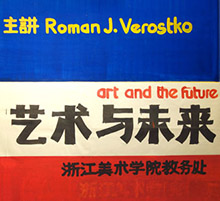 |
East / West Dichotomy: Is There A Middle Way? by Zheng Shengtian. Presentation for "The Culture of Culture: East / West a False Dichotomy? 4th International Sculpture Symposium", University of Minnesota, Minneapolis, February 18 -22, 2009 |